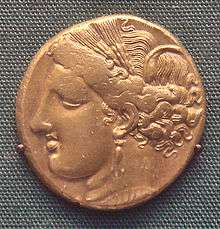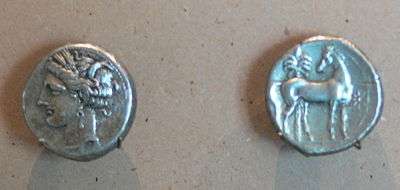Carthaginian currency





Carthaginian or Punic currency refers to the coins of ancient Carthage, a Phoenician city-state located near present-day Tunis, Tunisia.
Name
The base currency was the shekel, although its Punic pronunciation was probably /səˈḳel/.[1]
History
The Phoenicians, despite their extensive trading empires, began minting coins relatively late. Siculo-Carthaginian currency began to be issued in the mid-4th century and probably preceded Phoenicia's own Tyrian shekels, which developed c. 300 BC.[2]
Carthage issued ½-shekel,[3] shekel (7.20 g),[4] 1⅔-shekel, double shekel, and triple shekel coins.[5] 5-shekel pieces were issued in Sicily.[6] It used gold, silver, electrum, bronze, and billon for its coins but did not make great use of them in North Africa. Instead, many of the surviving caches come from Carthage's holdings on Sardinia and Sicily.[7] On Sardinia, a substantial amount of bronze coinage was struck during the First Punic War and again during the attempt to recover the island amid the Second.[8] A large mass of bronze and silver coins and smaller issues in gold and electrum were struck on Sicily under administrators described as MHSBM.[9] The Siculo-Carthaginian issues of the First Punic War include one series featuring Melqart ("Hercules") obverse and a horse's head reverse.[6] More commonly, Carthaginian currency featured a female head identified as the goddess Tanit.[10] One issue of bronze coins in two denominations—Tanit on the obverse and a galloping horse reverse—was coined at Kerkouane on Cape Bon during the resistance to the invasion of Regulus amid the First Punic War.[7] A great deal of highly debased coins were struck at the end of the First Punic War, however, to deal with the empire's revolting mercenaries.[11]
Between the First and Second Punic Wars, Carthage only issued bronze coins in North Africa,[11] although the Barcids issued gold and silver coins in Spain[4] bearing the head of Melqart obverse and a horse and palm tree reverse.[12] The gold coins were produced at a weight of 7.50 g, reflecting a value of 12 silver shekels each at a bullion exchange rate of 1:11⅓.[4] Spanish expansion and Roman plunder permitted issues in precious metals during the Second Punic War,[11] including two large silver issues for use on Sicily.[13] One set of half-shekels featured a diademed male head obverse and elephant reverse; another featured a male head with grain wreath obverse and a galloping horse reverse.[14] By the war's end, bronze was again being used[11] and, following the war, debased silver.[15] The shekel also decreased in Barcid areas from 7.2 to around 7.0 g over the course of the war.[4] Bronze coins similarly varied in weight between 8 and 10 g owing to varying exchange rates between it and the silver currency.[4] The last issues before the Third Punic War attest to the city's revitalization, as they are again pure silver[15] with a serrate edge.[16]
Numidian coins also circulated but were entirely of bronze.[17]
Recently, it has been proposed that the Germanic penny, penning, Pfennig, &c. may derive from an early borrowing of Punic PN (Pane or Pene, "Face"), as the face of Carthaginian fertility goddess Tanit was represented on nearly all Carthaginian currency.[18] The theory is, however, still disputed. Similarly, the supposed discovery of a cache of Carthaginian coins on Corvo in 1749 is the basis for supposing that the Carthaginians reached the Azores, but remains contentious.[19]
Remains
A collection of recovered coins is maintained at the Money Museum (French: Musée de la Monnaie en Tunisie) at the Central Bank in Tunis.[20]
See also
References
Citations
- ↑ Vennemann (2013b), p. 487.
- ↑ Bronson (1976), p. 8.
- ↑ Crawford (1985), p. 137.
- 1 2 3 4 5 Crawford (1985), p. 87.
- ↑ Crawford (1985), p. 135.
- 1 2 Crawford (1985), p. 106.
- 1 2 Crawford (1985), p. 133.
- ↑ Crawford (1985), p. 103.
- ↑ Crawford (1985), p. 104–5.
- ↑ Vennemann (2013a).
- 1 2 3 4 Crawford (1985), p. 136.
- ↑ Crawford (1985), p. 88.
- ↑ Crawford (1985), p. 109.
- ↑ Crawford (1985), p. 108.
- 1 2 Crawford (1985), p. 138.
- ↑ Crawford (1985), p. 139.
- ↑ Crawford (1985), p. 140.
- ↑ Vennemann (2013a), p. 467.
- ↑ Bikai, Pierre M.; et al. (January 1990), "Timelines: A Phoenician Fable", Archaeology.
- ↑ "Museum", The Central Bank of Tunisia, retrieved 9 February 2016.
Bibliography
- Bronson, Bennet (November 1976), "Cash, Cannon, and Cowrie Shells: The Nonmodern Moneys of the World", Bulletin, Vol. 47, No. 10, Chicago: Field Museum of Natural History, pp. 3–15.
- Crawford, Michael Hewson (1985), Coinage and Money under the Roman Republic: Italy and the Mediterranean Economy, The Library of Numismatics, Berkeley: University of California Press, ISBN 0-520-05506-3.
- Vennemann, Theo (2013a), "Ne'er-a-Face: A Note on the Etymology of Penny, with an Appendix on the Etymology of Pane", Germania Semitica, Trends in Linguistics: Studies and Monographs, No. 259, Walter de Gruyter, pp. 467–484, ISBN 978-3-11-030094-9.
- Vennemann, Theo (2013b), "A Note on the Etymology of Germanic +skellingaz 'Shilling': with an Appendix on Latin Siliqua 'A Small Coin'", Germania Semitica, pp. 485–496.